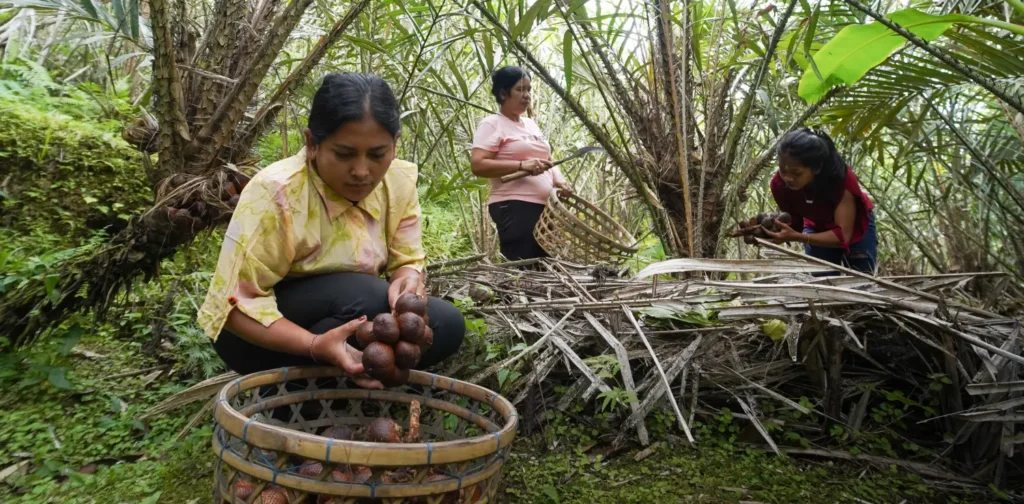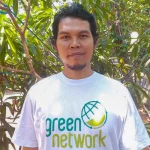Bali’s Snake Fruit Agroforestry System Is an Agricultural Heritage

Snake fruit farmers in Bali, Indonesia. | Photo: Ministry of Agriculture.
The tropics have a lot of delicious fruits to offer, including the snake fruit or salak from Indonesia. One of the most important things to highlight is how the fruit is cultivated, as it is linked with agricultural systems and various life aspects. In this context, the snake fruit agroforestry system in Bali, Indonesia, is recognized as Globally Important Agricultural Heritage Systems (GIAHS) by the UN’s Food and Agriculture Organization (FAO).
Snake Fruit Cultivation
Bali, Indonesia, is famous for its tourism with natural landscape, rich culture, and friendly locals. Beyond that, Bali also has many local fruits to enjoy, like snake fruits or salak.
The first source of snake fruit cultivation in Bali comes from the Sibetan Village in Karangasem Regency, known as the driest part of the island. This village sits 500–600 meters above sea level, with dry land, wet climate, and primarily laterite soil. With time, snake fruit cultivations spread to other regencies like Gianyar, Bangli, Badung, Tabanan, and Buleleng.
The snake fruit itself is diverse. In the Sibetan Village alone, there are at least 15 cultivars of snake fruits, such as salak gondoh, salak getih, salak cengkeh, and many others. Each variety has its own distinct flavor, color, texture, tree size, and leaf shape.
Bali’s Snake Fruit Agroforestry
Unlike the general snake fruit cultivation, Bali, especially the Karangasem Regency, utilizes the traditional agroforestry system. It integrates snake fruit cultivation with other plants like mangos, bananas, coconuts, and medicinal plants. This system was developed by Bali’s Indigenous communities using subak, a traditional water management system. Snake fruit trees grow under taller trees that protect the water source, creating an agricultural landscape with rich biodiversity that combines cultural values and ecological sustainability.
This way, snake fruit trees grow healthier and protected from pests, with a more stable soil moisture. The snake fruit agroforestry method also helps maintain topography, prevent erosion, save water, absorb carbon, and support food security as well as conserving local cultural heritage and livelihood.
Rooted in Bali’s traditional philosophy like “Tri Hita Karana” and “Tri Mandala”, this system reflects harmony among human, nature, and spirituality, as noted on the UNESCO’s Cultural Landscape. Bali’s snake fruit agroforestry system has been passed down from generation to generation. With this, Balinese people cultivate snake fruits without destroying their forests. They also utilize all parts of the snake fruit tree to minimize waste.
In September 2024, FAO recognized Bali’s snake fruit agroforestry system as one of the Globally Important Agricultural Heritage Systems (GIAHS). This addition came together with the carp pond farming in Austria and the cacao agroforestry system in Sao Tome and Principe. With these three additions, the GIAHS list has 89 agricultural systems from 28 countries.
Mainstreaming Nature-based Agricultural Systems
The agricultural sector is one of the most strategic sectors due to its intersection with history, livelihood, food security, nature conservation, and others. Bali’s snake fruit agroforestry system has emphasized that nature-based agricultural systems can be a worthy solution amidst widespread ecological destruction, particularly caused by unsustainable agriculture. Regions with rich natural resources, like Indonesia, have significant potential and opportunity to develop similar systems. Of course, successful implementation requires support, action, and commitment from all stakeholders in the sector.
Translator: Nazalea Kusuma
The original version of this article is published in Indonesian at Green Network Asia – Indonesia.

Join Green Network Asia Membership
Amidst today’s increasingly complex global challenges, equipping yourself, team, and communities with interdisciplinary and cross-sectoral insights on sustainability-related issues and sustainable development is no longer optional — it is a strategic necessity to stay ahead and stay relevant.
Join Now
Abul Muamar
Amar is the Manager of Indonesian Digital Publications at Green Network Asia. He holds a Master’s degree in Philosophy from Universitas Gadjah Mada and a Bachelor’s degree in Communication Studies from Universitas Sumatera Utara. He has over ten years of professional experience in journalism as a reporter and editor for several national-level media companies in Indonesia. He is also a writer, editor, and translator with a particular interest in socio-economic and environmental issues.


 Weaving the Thread Between the Last Elephant and the Floods in Sumatra
Weaving the Thread Between the Last Elephant and the Floods in Sumatra  Bringing Buried Rivers Back to Life Through Daylighting
Bringing Buried Rivers Back to Life Through Daylighting  Prescribing Beyond Profit for CEOs’ Anxiety
Prescribing Beyond Profit for CEOs’ Anxiety  An Interview with May Tan-Mullins, CEO and Provost of University of Reading Malaysia
An Interview with May Tan-Mullins, CEO and Provost of University of Reading Malaysia  An Interview with Eu Chin Fen, CEO of Frasers Hospitality
An Interview with Eu Chin Fen, CEO of Frasers Hospitality  The UK Government’s Funding Package Plan to Tackle Youth Unemployment
The UK Government’s Funding Package Plan to Tackle Youth Unemployment